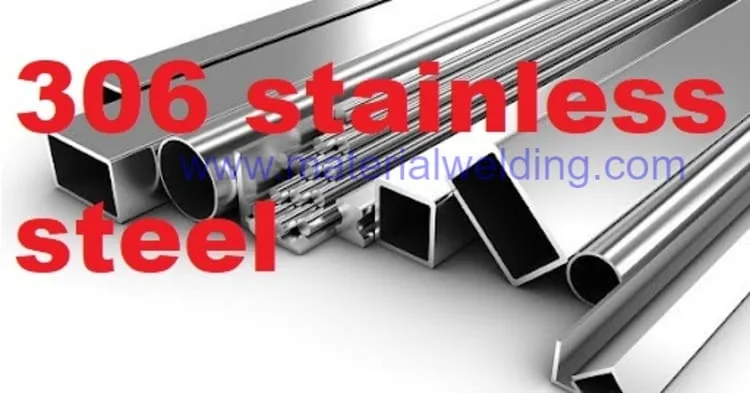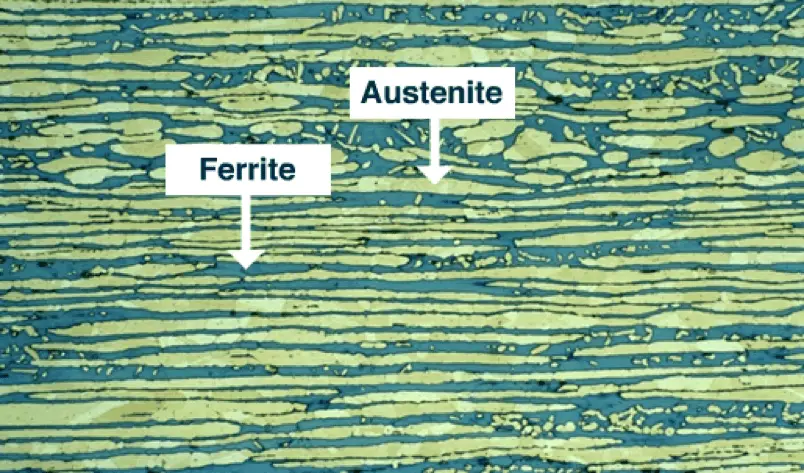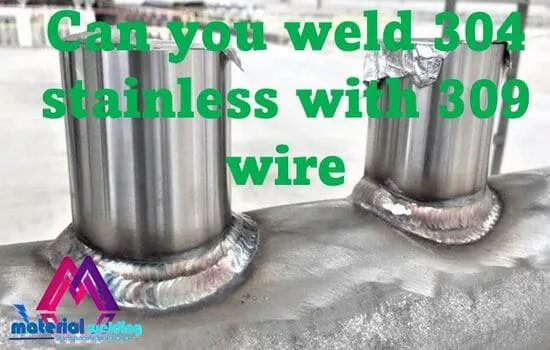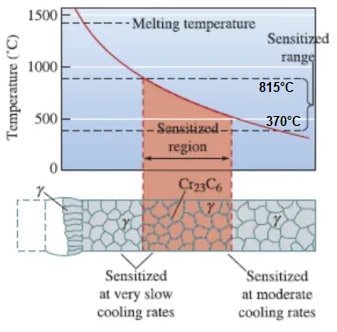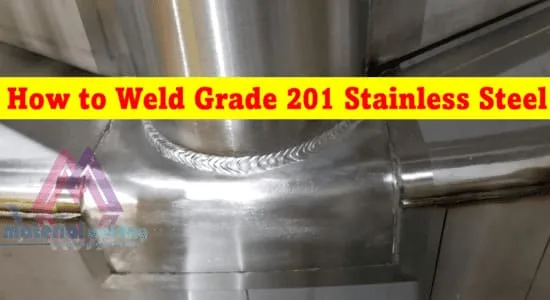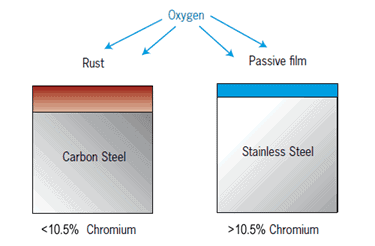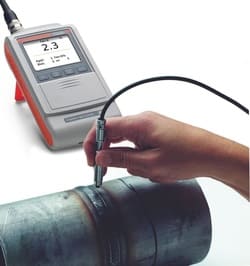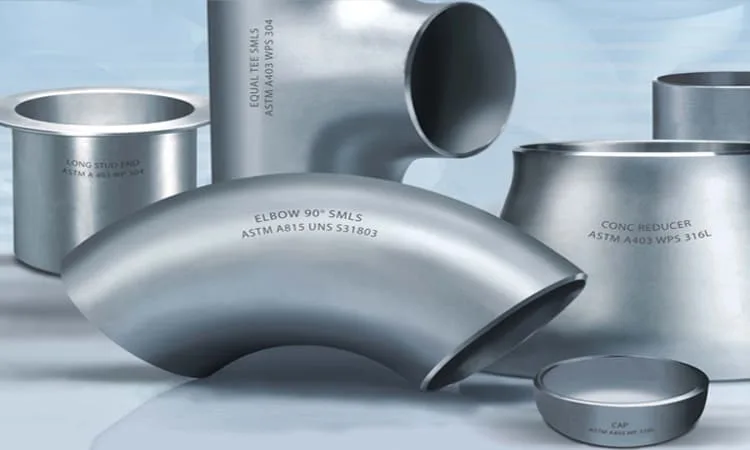Austenitic Stainless steel is one of the most widely used materials in various industries (more than 65% out of all stainless-steel types), including construction, food processing, and transportation, among others.
Among the various types of stainless steel, austenitic stainless steel is one of the most popular.
In this article, we will discuss what austenitic stainless steel is, its common grades, properties, and applications.
What is Austenitic Stainless Steel?
Austenitic stainless steel is a type of stainless steel that is composed of austenite, a face-centered cubic crystal structure.
It contains a high amount of chromium and nickel, which gives it excellent corrosion resistance and makes it non-magnetic.
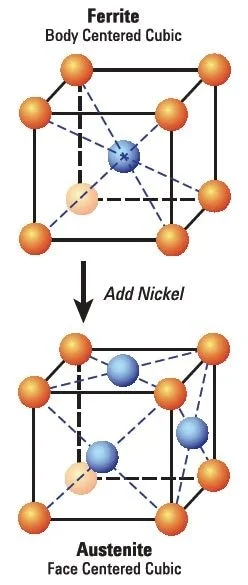
Additionally, it has good formability, weldability, and high-temperature strength.
Austenitic stainless steels have a nickel content, which is usually 8% or higher. By adding nickel and/or molybdenum, a chrome steel becomes an austenitic steel.
They got their name because of the austenitic structure.
Due to the advantageous composition of alloying elements, an excellent combination of corrosion resistance, ductility and toughness is achieved.
Therefore, they represent a wide range of applications, from household appliances to the food, chemical or mechanical engineering industries.
Austenitic steels are also known as chromium-nickel steels because their main alloying elements are chromium and nickel.
The minimum content of chromium is 13.5%, whereby values such as 14% or 16% can also be found in many grades.
Common Austenitic Stainless Steel Grades

There are many grades of austenitic stainless steel, each with slightly different compositions and properties. Below are some of the most common grades:
Grade 201 Stainless Steel
Grade 201 stainless steel (UNS Number: S20100) is a low-cost alternative to 304 stainless steel and is often used in decorative applications.
It has a higher manganese content than other austenitic stainless steels, which provides increased strength and ductility.
Chemical composition:
- Chromium: 16-18%
- Nickel: 3.5-5.5%
- Manganese: 5.5-7.5%
- Silicon: 1.0% max
- Carbon: 0.15% max
- Nitrogen: 0.25% max.
- Sulfur: 0.030 max
- Phosphorus: 0.060 max.
Mechanical properties:
- Ultimate tensile strength: 515 MPa (75 Ksi) minimum.
- Yield strength: 260 MPa (38 Ksi) minimum.
- Elongation: 40% minimum.
- Hardness: 217 HBW
Applications:
- Decorative applications
- Household items
- Automotive trim
Grade 202 Stainless Steel
Grade 202 stainless steel (UNS Number: S20200) is similar to grade 201 stainless steel but has a higher chromium content.
It is often used in applications where corrosion resistance is not critical, such as in cookware and utensils.
Chemical composition:
- Chromium: 17-19%
- Nickel: 4-6%
- Manganese: 7.5-10%
- Silicon: 1.0% max
- Carbon: 0.15% max
- Nitrogen: 0.25% max.
- Sulfur: 0.030 max
- Phosphorus: 0.060 max.
Mechanical properties:
- Ultimate tensile strength: 620 MPa (90 Ksi) minimum.
- Yield strength: 260 MPa (38 Ksi) minimum.
- Elongation: 40% minimum.
- Hardness: 241 HBW
Applications:
- Cookware and utensils
- Decorative applications
Grade 301 Stainless Steel
Grade 301 stainless steel (UNS Number: S30100) is a high-strength austenitic stainless steel that is often used in applications that require high strength and ductility.
It has a lower nickel content than other austenitic stainless steels, which makes it more affordable.
Chemical composition:
- Chromium: 16-18%
- Nickel: 6-8%
- Silicon: 1.0% max
- Manganese: 2.0% max
- Carbon: 0.15% max
- Nitrogen: 0.10% max.
- Sulfur: 0.030 max
- Phosphorus: 0.045 max.
Mechanical properties:
- Ultimate tensile strength: 515 MPa (75 Ksi) minimum.
- Yield strength: 205 MPa (30 Ksi) minimum.
- Elongation: 40% minimum.
- Hardness: 217 HBW
Applications:
- Springs
- Structural components
- Automotive trim
Grade 302 Stainless Steel
Grade 302 stainless steel (UNS Number: S30200) is a variant of grade 304 stainless steel with a higher carbon content, which provides increased strength and hardness.
It is often used in applications that require high strength and corrosion resistance.
Chemical composition:
- Chromium: 17-19%
- Nickel: 8-10%
- Silicon: 0.75% max
- Manganese: 2.0% max
- Carbon: 0.15% max
- Nitrogen: 0.10% max.
- Sulfur: 0.030 max
- Phosphorus: 0.045 max.
Mechanical properties:
- Ultimate tensile strength: 515 MPa (75 Ksi) minimum.
- Yield strength: 205 MPa (30 Ksi) minimum.
- Elongation: 40% minimum.
- Hardness: 201 HBW
Applications:
- Springs
- Fasteners
- Surgical instruments
Grade 304:
This is the most common austenitic stainless steel (UNS Number: S30200) and is often referred to as “18-8” stainless steel because it contains 18% chromium and 8% nickel.
It has a low carbon content, making it resistant to sensitization and carbide precipitation during welding. Grade 304 also exhibits good corrosion resistance and excellent formability and weldability.
Chemical composition:
- Chromium: 17-19%
- Nickel: 8-10%
- Silicon: 0.75% max
- Manganese: 2.0% max
- Carbon: 0.15% max
- Nitrogen: 0.10% max.
- Sulfur: 0.030 max
- Phosphorus: 0.045 max.
Mechanical properties:
- Ultimate tensile strength: 515 MPa (75 Ksi) minimum.
- Yield strength: 205 MPa (30 Ksi) minimum.
- Elongation: 40% minimum.
- Hardness: 201 HBW
Applications:
- Kitchen equipment
- Food processing equipment
- Chemical containers Heat exchangers
- architectural applications
Related Reading: Welding Guidelines for 304 Stainless Steel.
Grade 309 Stainless Steel
Grade 309 stainless steel (UNS Number: S30908) is a high-temperature austenitic stainless steel that is often used in high-temperature applications.
It has a higher chromium and nickel content than other austenitic stainless steels, which provides increased strength and corrosion resistance at high temperatures.
Chemical composition:
- Chromium: 22-24%
- Nickel: 12-15%
- Silicon: 0.75% max
- Manganese: 2.0% max
- Carbon: 0.08% max
- Sulfur: 0.030 max
- Phosphorus: 0.045 max.
Mechanical properties:
- Ultimate tensile strength: 515 MPa (75 Ksi) minimum.
- Yield strength: 205 MPa (30 Ksi) minimum.
- Elongation: 40% minimum.
- Hardness: 217 HBW
Applications:
- Furnace parts
- Heat exchangers
Grade 310 Stainless Steel
Grade 310 stainless steel (UNS Number: S30200) is a high-temperature austenitic stainless steel that is often used in applications that require high resistance to oxidation and corrosion at high temperatures. It has a high chromium and nickel content, which provides excellent corrosion resistance and strength at elevated temperatures.
Grade 310 Stainless is available in different grades as:
- SS310
- SS310S
- SS310H
- SS310Cb
- SS310HCb
- SS310MoLN
Chemical composition of Grade 310S:
- Chromium: 24-26%
- Nickel: 19-22%
- Silicon: 1.50% max
- Manganese: 2.0% max
- Carbon: 0.108% max
- Sulfur: 0.030 max
- Phosphorus: 0.045 max.
Mechanical properties:
- Ultimate tensile strength: 515 MPa (75 Ksi) minimum.
- Yield strength: 205 MPa (30 Ksi) minimum.
- Elongation: 40% minimum.
- Hardness: 217 HBW
Applications:
- Furnace parts
- Heat exchangers
- Thermal processing equipment
Related Reading: Welding Guidelines for 310 Stainless Steel.
Grade 316:
This grade is similar to 304 but with the addition of 2-3% molybdenum, which improves its corrosion resistance, particularly in chloride environments. It is often used in marine applications and medical implants.
Grade 316 stainless steel (UNS Number: S30200) is a molybdenum-bearing austenitic stainless steel that has improved resistance to corrosion compared to 304 stainless steel.
Grade 316 has a higher nickel content of 10-14% and a lower carbon content, making it more resistant to corrosion in high-temperature environments. Grade 316 also exhibits excellent formability and weldability.
Chemical composition:
- Chromium: 16-18%
- Nickel: 10-14%
- Molybdenum: 2-3%
- Silicon: 0.75% max
- Manganese: 2.0% max
- Carbon: 0.08% max
- Nitrogen: 0.10% max.
- Sulfur: 0.030 max
- Phosphorus: 0.045 max.
Mechanical properties:
- Ultimate tensile strength: 515 MPa (75 Ksi) minimum.
- Yield strength: 205 MPa (30 Ksi) minimum.
- Elongation: 40% minimum.
- Hardness: 217 HBW
Applications:
- Chemical and pharmaceutical processing equipment
- Marine applications
- Medical devices
- Heat exchangers.
Related Reading: Welding Guidelines for 316 Stainless Steel.
Grade 317 Stainless Steel
Grade 317 stainless steel (UNS Number: S30200) is a high-alloy austenitic stainless steel that contains molybdenum and higher levels of nickel and chromium than other austenitic stainless steels.
It has excellent corrosion resistance and high strength, making it suitable for use in high-temperature and corrosive environments.
Chemical composition:
- Chromium: 18-20%
- Nickel: 11-15%
- Molybdenum: 3-4%
- Silicon: 0.75% max
- Manganese: 2.0% max
- Carbon: 0.08% max
- Nitrogen: 0.10% max.
- Sulfur: 0.030 max
- Phosphorus: 0.045 max.
Mechanical properties:
- Ultimate tensile strength: 515 MPa (75 Ksi) minimum.
- Yield strength: 205 MPa (30 Ksi) minimum.
- Elongation: 35% minimum.
- Hardness: 217 HBW
Applications:
- Chemical processing equipment
- Power generation equipment
- Pharmaceutical equipment
Grade 321:
Grade 321 stainless steel (UNS Number: S30200) is a stabilized austenitic stainless steel that contains titanium, which provides stabilization against sensitization (chromium carbide precipitation) and intergranular corrosion.
Grade 321 has a higher carbon content compared to 304 and 316 stainless steel, making it more resistant to high-temperature environments. It is often used in high-temperature applications such as aircraft exhaust systems.
Chemical composition:
- Chromium: 17-19%
- Nickel: 9-12%
- Titanium: Ti 5 × (C + N) min, 0.70 max
- Silicon: 0.75% max
- Manganese: 2.0% max
- Carbon: 0.08% max
- Nitrogen: 0.10% max.
- Sulfur: 0.030 max
- Phosphorus: 0.045 max.
Mechanical properties:
- Ultimate tensile strength: 515 MPa (75 Ksi) minimum.
- Yield strength: 205 MPa (30 Ksi) minimum.
- Elongation: 40% minimum.
- Hardness: 217 HBW
Applications:
- High-temperature chemical and processing equipment
- Aircraft exhaust manifolds
- Thermal oxidizers.
Related Reading: Welding Guidelines for 321 Stainless Steel.
Grade 347:
This grade is similar to 321 but with the addition of columbium, which improves its high-temperature strength. It is often used in applications that require high-temperature resistance, such as furnace parts and jet engine components.
Grade 347 stainless steel (UNS Number: S30200) is a stabilized austenitic stainless steel that contains niobium, which provides stabilization against sensitization and intergranular corrosion.
Grade 347 stainless steel has a higher resistance to corrosion compared to grade 321 stainless steel, making it suitable for high-temperature environments.
Chemical composition:
- Chromium: 17-19%
- Nickel: 8-10%
- Niobium (Cb): Cb 10 × C min, 1.00 max
- Silicon: 0.75% max
- Manganese: 2.0% max
- Carbon: 0.15% max
- Nitrogen: 0.10% max.
- Sulfur: 0.030 max
- Phosphorus: 0.045 max.
Mechanical properties:
- Ultimate tensile strength: 515 MPa (75 Ksi) minimum.
- Yield strength: 205 MPa (30 Ksi) minimum.
- Elongation: 40% minimum.
- Hardness: 201 HBW
Applications:
- High-temperature chemical and processing equipment
- Aircraft exhaust manifolds
- Thermal oxidizers.
Related Reading: Welding Guidelines for 347 Stainless Steel.
Grade 904L:
904L grade (UNS Number: N08904) contains a high amount of molybdenum and is often used in chemical processing and oil refining equipment due to its excellent corrosion resistance.
Chemical composition:
- Chromium: 19-23%
- Nickel: 23-28%
- Silicon: 1.0% max
- Manganese: 2.0% max
- Carbon: 0.20% max
- Nitrogen: 0.10% max.
- Copper: 1-2%
- Sulfur: 0.030 max
- Phosphorus: 0.045 max.
Mechanical properties:
- Ultimate tensile strength: 490 MPa (71 Ksi) minimum.
- Yield strength: 220 MPa (31 Ksi) minimum.
- Elongation: 35% minimum.
- Hardness: Not specified.
Applications:
- High-temperature chemical and processing equipment
- Aircraft exhaust manifolds
- Thermal oxidizers.
Related Reading: Welding Guidelines for 904L Stainless Steel.
Austenitic Stainless Steel Microstructure
The austenitic microstructure is characterized by a homogeneous and isotropic distribution of atoms in the crystal lattice, with a high degree of interstitial voids that allow for the easy diffusion of atoms within the material.
This microstructure is also non-magnetic, which makes it ideal for applications where magnetism could interfere with the function of the component.

The austenitic stainless steel microstructure is typically achieved through a process called solid solution strengthening, in which the nickel and chromium atoms are dissolved into the iron matrix at high temperatures.
This process results in a material with a high degree of ductility, excellent corrosion resistance, and good mechanical properties.
Properties of Austenitic Stainless Steel
The properties of austenitic stainless steel are as follows:
Corrosion resistance: Austenitic stainless steel has excellent corrosion resistance, particularly against pitting and crevice corrosion.
Non-magnetic: Due to its high nickel content, austenitic stainless steel is non-magnetic.
Formability: It has good formability and can be easily formed into complex shapes.
Weldability: Austenitic stainless steel is highly weldable and can be welded using various welding techniques.
High-temperature strength: It has good high-temperature strength and can withstand high temperatures without losing its strength.
Applications of Austenitic Stainless Steel
Due to its excellent corrosion resistance and other properties, austenitic stainless steel is used in various applications, including:
Kitchen equipment: Stainless steel appliances, sinks, and countertops are often made of austenitic stainless steel due to its corrosion resistance and ease of cleaning.
Chemical processing equipment: Austenitic stainless steel is often used in chemical processing equipment due to its corrosion resistance to various chemicals.
Medical implants: Due to its non-magnetic properties and corrosion resistance, austenitic stainless steel is often used in medical implants.
Transportation: Many parts of cars, trucks, and airplanes are made of austenitic stainless steel due to its high-temperature strength and corrosion resistance.
Architectural applications: Austenitic stainless steel is often used in architectural applications such as handrails, elevator doors, and building facades due to its corrosion resistance and aesthetic appeal.
FAQS
Q: What are austenitic stainless steels?
They are non-magnetic, highly corrosion-resistant, and can be easily formed and welded.
Q: What are the benefits of using austenitic stainless steels?
Q: What are some common applications for austenitic stainless steels?
They are also often used in household appliances such as refrigerators, dishwashers, and washing machines.
Q: What is the difference between 304 and 316 austenitic stainless steels?
However, 316 contains higher levels of molybdenum and nickel than 304, making it more resistant to corrosion in certain environments, such as those with higher levels of chlorides.
Q: Can austenitic stainless steels be welded?
Q: How can austenitic stainless steels be protected from corrosion?
To protect the material from corrosion, coatings such as paints or epoxy can be applied, or the material can be electropolished to restore the passive layer. Additionally, using higher alloyed austenitic stainless steels or duplex stainless steels can provide even higher corrosion resistance.
